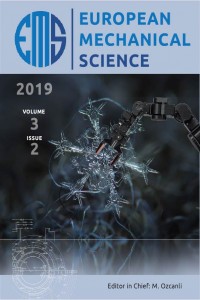A Study for Detecting Flow Lines on The Aesthetic Plastic Parts During Design Phases as Using Material Flow Analysis Programs
Abstract
In
today’s competitive business environment the automotive industries aim to
increase the usage of the plastic materials in automobile components in order
to reduce weight of the vehicles. Although the plastic materials provide a
considerable savings on vehicle weight, these materials have some problems to
be solved. One of the difficult problems encountered in the production of
plastics is the flow lines on plastics because of its unpredictable behavior.
As a result, considered problem faced by automobile companies often spend
plenty of time and money is an issue to resolve. In this study the source of
plastic flow lines on automotive external aesthetical parts are investigated by
using material flow analysis programs. According to conventional methodologies;
weld lines, temperature differences, filling times, clamping forces, shrinkages
parameters are examined deeply before tooling face especially to eliminate
aesthetical problems. But in this case we observed an unordinary situation such
as flow lines on front bumper visible surfaces after tooling phase and
therefore we searched a new approach to simulate this flow lines on the
material flow analysis program. Flow directions and flow velocity are
comprehensively examined step by step during filling analysis. As a result of
the analysis the geometric factors that affect the balance of flow and brings
turbulence are detected. After the root cause analysis for plastic deformation
the potential techniques are researched to find best solution. Analysis are repeated in the same conditions
that are considered to be made for all geometric changes. The experiment results are comparatively
analyzed and the solution approach that have the best flow balance is selected.
References
- Akbarzadeh A., Sadeghi M. (2011). Parameter Study in Plastic Injection Molding Process using Statistical Methods and IWO Algorithm. International Journal of Modeling and Optimization pp. 141.
- Lopes, N., & Ribeiro, B. (1999). Part quality prediction in an injection moulding process using neural networks. proceedings of WMC, ISM.
- Cheah, L. W. (2010). Cars on a diet: the material and energy impacts of passenger vehicle weight reduction in the US (Doctoral dissertation, Massachusetts Institute of Technology).
- Taghizadeh, S., Özdemir, A., & Uluer, O. (2013). Warpage prediction in plastic injection molded part using artificial neural network. Iranian Journal of Science and Technology. Transactions of Mechanical Engineering, 37(M2), 149.
- Guo, W., Hua, L., Mao, H., & Meng, Z. (2012). Prediction of warpage in plastic injection molding based on design of experiments. Journal of Mechanical Science and Technology, 26(4), 1133-1139.
- Park, K., Sohn, D. H., & Cho, K. H. (2010). Eliminating weldlines of an injection-molded part with the aid of high-frequency induction heating. Journal of mechanical science and technology, 24(1), 149-152.
- Rosato, D. V., & Rosato, M. G. (2012). Injection molding handbook. Springer Science & Business Media.
- Harper, C. A. (2006). Handbook of plastic processes. John Wiley & Sons.
- Frizelle W.G. (2016). Applied Plastic Engineering Handbook. 2nd ed. Part II. Chapter 10. pp. 191-203.
- Fuh, J. Y., Fu, M. W., & Nee, A. Y. C. (2004). Computer-aided injection mold design and manufacture. CRC Press.
- http://www.rpm-engineering.com/plastic.html
- Rännar L.-E. (2008). An Optimization of Injection Molding Cooling. pp. 5-11.
- Wang, J. (2012). PVT properties of polymers for injection molding. In Some Critical Issues for Injection Molding. IntechOpen. http://ayannaplastics.com
- Dealy, J. M., & Wissbrun, K. F. (2012). Melt rheology and its role in plastics processing: theory and applications. Springer Science & Business Media.
- Larson, E. R. (2015). Thermoplastic Material Selection: A Practical Guide. William Andrew.
- Autodesk Moldflow Troubleshooting Guide. ‘https://knowledge.autodesk.com/support/moldflow-insight/learn-explore/caas/CloudHelp/cloudhelp/2017/ENU/MoldflowInsight/files/GUID-3E3EFE66-AE31-4E50-831E-5944C5820ED6-htm.html’.
- https://knowledge.autodesk.com/support/moldflow-flex/learn-explore/caas/CloudHelp/cloudhelp/2014/ENU/MoldflowInsight360/files/GUID-8A317780-B538-40FB-9AD4-CB04B13FA82E-htm.html
- http://www.moldex3d.com/en/newsletter/achieve-plastic-part-dimension-accuracy-through-3d-volume-shrinkage-compensation-method
- https://knowledge.autodesk.com/support/moldflow-flex/learn-explore/caas/CloudHelp/cloudhelp/2015/ENU/MoldflowInsight360/files/GUID-099634AE-DB7A-41BA-B70C-5A23FB013B06-htm.html
- https://knowledge.autodesk.com/support/moldflow-insight/learn-explore/caas/CloudHelp/cloudhelp/2017/ENU/MoldflowInsight/files/GUID-706D3A91-F6EE-4577-8186-9381D967E13A-htm.html
Abstract
References
- Akbarzadeh A., Sadeghi M. (2011). Parameter Study in Plastic Injection Molding Process using Statistical Methods and IWO Algorithm. International Journal of Modeling and Optimization pp. 141.
- Lopes, N., & Ribeiro, B. (1999). Part quality prediction in an injection moulding process using neural networks. proceedings of WMC, ISM.
- Cheah, L. W. (2010). Cars on a diet: the material and energy impacts of passenger vehicle weight reduction in the US (Doctoral dissertation, Massachusetts Institute of Technology).
- Taghizadeh, S., Özdemir, A., & Uluer, O. (2013). Warpage prediction in plastic injection molded part using artificial neural network. Iranian Journal of Science and Technology. Transactions of Mechanical Engineering, 37(M2), 149.
- Guo, W., Hua, L., Mao, H., & Meng, Z. (2012). Prediction of warpage in plastic injection molding based on design of experiments. Journal of Mechanical Science and Technology, 26(4), 1133-1139.
- Park, K., Sohn, D. H., & Cho, K. H. (2010). Eliminating weldlines of an injection-molded part with the aid of high-frequency induction heating. Journal of mechanical science and technology, 24(1), 149-152.
- Rosato, D. V., & Rosato, M. G. (2012). Injection molding handbook. Springer Science & Business Media.
- Harper, C. A. (2006). Handbook of plastic processes. John Wiley & Sons.
- Frizelle W.G. (2016). Applied Plastic Engineering Handbook. 2nd ed. Part II. Chapter 10. pp. 191-203.
- Fuh, J. Y., Fu, M. W., & Nee, A. Y. C. (2004). Computer-aided injection mold design and manufacture. CRC Press.
- http://www.rpm-engineering.com/plastic.html
- Rännar L.-E. (2008). An Optimization of Injection Molding Cooling. pp. 5-11.
- Wang, J. (2012). PVT properties of polymers for injection molding. In Some Critical Issues for Injection Molding. IntechOpen. http://ayannaplastics.com
- Dealy, J. M., & Wissbrun, K. F. (2012). Melt rheology and its role in plastics processing: theory and applications. Springer Science & Business Media.
- Larson, E. R. (2015). Thermoplastic Material Selection: A Practical Guide. William Andrew.
- Autodesk Moldflow Troubleshooting Guide. ‘https://knowledge.autodesk.com/support/moldflow-insight/learn-explore/caas/CloudHelp/cloudhelp/2017/ENU/MoldflowInsight/files/GUID-3E3EFE66-AE31-4E50-831E-5944C5820ED6-htm.html’.
- https://knowledge.autodesk.com/support/moldflow-flex/learn-explore/caas/CloudHelp/cloudhelp/2014/ENU/MoldflowInsight360/files/GUID-8A317780-B538-40FB-9AD4-CB04B13FA82E-htm.html
- http://www.moldex3d.com/en/newsletter/achieve-plastic-part-dimension-accuracy-through-3d-volume-shrinkage-compensation-method
- https://knowledge.autodesk.com/support/moldflow-flex/learn-explore/caas/CloudHelp/cloudhelp/2015/ENU/MoldflowInsight360/files/GUID-099634AE-DB7A-41BA-B70C-5A23FB013B06-htm.html
- https://knowledge.autodesk.com/support/moldflow-insight/learn-explore/caas/CloudHelp/cloudhelp/2017/ENU/MoldflowInsight/files/GUID-706D3A91-F6EE-4577-8186-9381D967E13A-htm.html
Details
| Primary Language | English |
|---|---|
| Journal Section | Research Article |
| Authors | |
| Publication Date | June 20, 2019 |
| Acceptance Date | April 21, 2019 |
| Published in Issue | Year 2019 Volume: 3 Issue: 2 |


